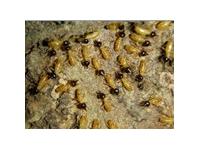Confused Flour Beetle (Also see Rust-Red Flour Beetle)
Granary Weevil (Also see Rice Weevil)
Mediterranean Flour Moth or Mill Moth
Red-legged Ham or Copra Beetle
Rice Weevil (Also see Granary Weevil)
Rust-Red Flour Beetle (Also see Confused Flour Beetle)
Tropical Warehouse or Almond Moth (Also see Warehouse, Tobacco or Cocoa Moth)
Warehouse, Tobacco or Cocoa Moth (Also see Tropical Warehouse or Almond Moth)

Notes
Conehead termites are an invasive species native to the Caribbean. They were first introduced to the U.S. in 2001. Originally called "tree termites," they were renamed conehead termites to alleviate the misconception that this pest is only found in trees.
Though the species was believed to have been eradicated in the U.S. in 2003, the Florida Department of Agriculture and Consumer Services (DACS) recently confirmed the reemergence of this pest in Broward County, Florida.
Habits
Unlike most termites, the conehead termite does not rely on underground tunneling to travel. Instead, they forage on the ground like ants, allowing them to spread quickly.
Habitat
Conehead termites build dark brown “mud” tubes and freestanding nests on the ground, in trees or in wooden structures. The nests can be up to 3 feet in diameter and have a hard surface of chewed wood.
Threats
Conehead termites are an extremely aggressive termite species known for causing widespread property damage in a short period of time. Additional research into the species and treatment options are critical to controlling this destructive pest’s spread, or else millions of dollars in damage can be expected.

